Water Filter bag
-
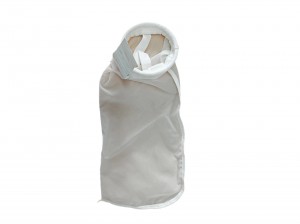
Nylon Water Filter Bag: Unmatched Performance Opens a New Era of Filtration
In today’s era of evolving water filtration technology, the nylon water filter bag stands out with its unique advantages, becoming the ideal choice for many industries to achieve efficient water filtration.
Nylon, as the core material for making filter bags, possesses numerous excellent properties. The high strength of nylon ensures that the filter bags have excellent mechanical performance, enabling them to withstand significant water pressure without being damaged. Additionally, its wear resistance, chemical resistance, and water resistance are all outstanding. When dealing with complex water quality environments, such as industrial wastewater containing acidic or alkaline substances, nylon water filter bags can perform stable filtration work thanks to their chemical corrosion resistance, without being affected by chemical substances and thus not shortening their service life.
The filtration accuracy range of nylon water filter bags is quite wide, typically ranging from 20 microns to 1000 microns. This diverse range of accuracy options meets the needs of different industries and different filtration stages. In some occasions where water quality requirements are relatively low, such as the pre-treatment of industrial wastewater, larger precision nylon water filter bags can quickly and effectively intercept large particles of impurities, such as sand and large suspended solids, laying the foundation for subsequent more precise treatment steps. In fields with extremely high water quality requirements, such as ultra-pure water production in the electronics industry and sterile water production in the pharmaceutical industry, smaller precision nylon water filter bags can precisely filter out microorganisms, bacteria, tiny particles, and colloids, ensuring that the produced water meets strict standards.
From the perspective of manufacturing process, nylon water filtration bags are usually made by precisely weaving nylon single filaments and processing them with special auxiliary materials. The weaving structure is tight and uniform, ensuring the stability and consistency of the filtration bag during the filtration process. Moreover, the surface of the nylon single filaments is smooth, which not only enables the liquid to pass through the filtration bag smoothly, improving the filtration efficiency, but also makes the impurities intercepted not easily adhere to the surface of the filtration bag. When cleaning is needed, the impurities can easily fall off, greatly enhancing the convenience of cleaning, and thus enabling the filtration bag to be reused multiple times, reducing the long-term usage cost.
In terms of practical application, nylon water filtration bags play a significant role in various industries. In the food and beverage sector, they are involved in the production of juices, edible oils, and wine. In juice production, they remove larger particles such as pulp during the coarse filtration stage, ensuring the smooth progress of the production process. Subsequently, in the fine filtration stage, they can also filter out small gelatinous particles, thereby improving the quality and taste of the juice. In the wine-making process, after initially filtering out impurities such as wine residue, nylon water filtration bags can further filter before bottling to prevent microbial contamination and extend the shelf life of the wine.
-
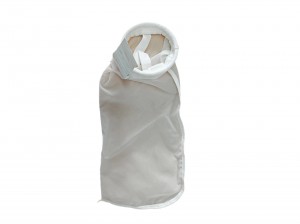
Nylon water filter bag: Highly efficient filtration, safeguarding water quality
In the field of water treatment, efficient filtration equipment plays a crucial role in ensuring the purity of water quality. The nylon water filter bag, as a highly performing filtration product, is widely used in various water filtration scenarios.
The nylon water filter bag is made of high-strength nylon material and its unique weaving process gives it many advantages. Firstly, its excellent compressive strength ensures that it does not deform even under high water pressure, maintaining a stable filtration effect. Whether in large-scale water treatment in industrial production or small-scale filtration systems in households, this stability is of vital importance.
Secondly, the surface of the nylon water filter bag is smooth, which makes it easy to clean. When the filter bag traps a large amount of impurities, simply rinsing or using an appropriate cleaning method can quickly restore its filtration performance, and it can be reused. This not only significantly reduces the usage cost but also aligns with the environmental protection concept.In terms of filtration accuracy, the nylon water filter bag can meet different requirements. It usually has multiple precision specifications available, ranging from coarse filtration to a certain degree of fine filtration. In some less stringent pre-filtration stages, such as the preliminary treatment before industrial wastewater discharge, the nylon water filter bag can quickly intercept large particles in the water, such as sand, fibers, and plastic blocks, reducing the burden on subsequent deep treatment. In some scenarios with higher water quality requirements, such as the initial filtration stage in the preparation of ultra-pure water for electronic industries, it can also play an important role in filtering out residual tiny particles, colloids, and other impurities, ensuring that the water entering the subsequent treatment process meets certain standards.
In practical application scenarios, the nylon water filter bag demonstrates strong applicability. In the pre-filtration stage of water treatment, whether in municipal sewage treatment plants for the initial treatment of raw water or in industrial internal circulation water systems for impurity removal, the nylon water filter bag can work efficiently. In the petrochemical industry, it can be used to treat various wastewater produced during the production process, ensuring that the discharged water meets environmental protection requirements, and can also filter some process water for use in subsequent treatment processes, ensuring the smooth operation of production.
In the light industry, food and beverage sectors, the nylon water filter bag is indispensable. For example, in the juice production process, it can remove large particles such as pulp and residue in the coarse filtration stage, ensuring the smoothness of the subsequent production process. In wine brewing, it can remove impurities such as wine residue in the initial filtration stage, improving the quality of the wine.
In addition, in solid-liquid separation and treatment in fields such as metallurgy, electronics, and pharmaceuticals, the nylon water filter bag also has wide applications. In the water treatment process of the biopharmaceutical industry, it can filter out possible micro-impurities such as microorganisms and bacteria in the water, providing pure water for drug production, ensuring the quality and safety of drugs.
The nylon water filter bag, with its outstanding performance, wide applicability, and good cost-effectiveness, has become a highly favored filtration product in the water treatment field, safeguarding every drop of pure water for us. -
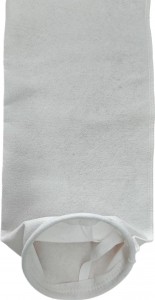
Water Filtration Bags: Innovation and Practical Guide
In the ever-evolving wave of water treatment technology, water filtration bags have always held a significant position. As an efficient and convenient filtering device, the technological innovation of water filtration bags has never ceased, providing better solutions for various water treatment needs in different industries.
Today, water filtration bags have made more breakthroughs in materials. Besides the traditional polypropylene, polyester, etc., new composite materials of water filtration bags have emerged. These composite materials combine the advantages of multiple materials, not only improving the filtration accuracy but also enhancing the temperature resistance, acid and alkali resistance, etc., allowing water filtration bags to function in more complex environments. For example, some composite material water filtration bags can maintain stable filtration effects at high temperatures, meeting the special needs of high-temperature industrial wastewater treatment.
In terms of structural design, water filtration bags have also seen significant improvements. Previously, water filtration bags were mostly simple bag-shaped structures, while now there are multi-ridged designs of water filtration bags. This design increases the filtration area, enhances the pollutant-capturing capacity, prolongs the service life of water filtration bags, reduces the replacement frequency, and saves costs for enterprises. At the same time, some water filtration bags adopt interface designs with better sealing performance, avoiding leakage during the filtration process and ensuring the stability of the filtration effect.
The application of water filtration bags cannot be separated from the correct usage methods. When choosing water filtration bags, one should select the appropriate material and precision based on water quality conditions and filtration requirements. When installing water filtration bags, ensure proper installation and good sealing to avoid affecting the filtration effect due to improper installation. During use, regularly check the usage status of water filtration bags. When the filtration efficiency decreases or the pressure difference increases, replace the water filtration bags in time to ensure the normal operation of the water treatment system.
In addition, the maintenance and care of water filtration bags are also very important. For washable water filtration bags, follow the correct methods for cleaning to remove impurities on the surface and restore their filtration performance. For disposable water filtration bags, do a good job in waste disposal to avoid environmental pollution.
With the continuous improvement of environmental awareness, water filtration bags play an increasingly important role in water resource recycling. Efficient water filtration bags can treat industrial wastewater, domestic sewage, etc., and reuse them, improving water resource utilization and reducing sewage discharge, contributing to the environmental protection cause.
In conclusion, water filtration bags, with their continuous technological innovation and practical performance, have a very broad application prospect in the field of water treatment. Correct selection, use, and maintenance of water filtration bags can make them function better, providing better water quality guarantees for our production and life.
-
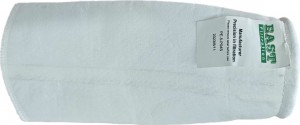
The wide application of water filtration bags: Protecting every drop of water in life and industry
The wide application of water filtration bags: Protecting every drop of water in life and industry
Water, as the source of life, plays an indispensable role in our daily life and industrial production. To ensure the purity and safety of water, water filtration bags are indispensable as a powerful assistant. With their efficient filtration performance and diverse features, water filtration bags have been widely applied in numerous fields and have become a solid defense line for protecting every drop of water.In the electronics industry, water filtration bags play a crucial role. The manufacturing of electronic components has extremely high requirements for water quality. Even the slightest impurities can affect the performance and quality of electronic products. For instance, during chip manufacturing, ultra-pure water is used to clean the surface of chips to ensure high precision and stability of the chips. Water filtration bags can precisely filter out particles, microorganisms, and organic substances in the water, providing nearly perfect pure water for chip manufacturing. At the pre-treatment stage of process water, water filtration bags also play an important role, removing large particles and colloidal substances in the water, reducing the burden on subsequent deep treatment equipment and improving the operational efficiency of the entire water treatment system. Moreover, in aspects such as tape coating agents and air pre-filtration, water filtration bags also provide reliable guarantees for the production environment of the electronics industry, ensuring the stable operation of electronic equipment and the reliability of product quality.
The food and beverage industry is closely related to our daily lives, and water filters are a crucial part in ensuring food safety and beverage quality. In the processing of products such as fruit juice, mineral water, milk, beer, brewing, vinegar production, and edible oil, water is an indispensable raw material. Water filters can effectively remove impurities, microorganisms, and odors from water, ensuring the taste and quality of the products. For example, in the production of mineral water, water filters can filter out mineral particles and microorganisms in the water, making the mineral water clearer and purer, and meeting national hygiene standards. In the brewing process of beer, water filters can remove impurities and odors from the water, providing high-quality water sources for the fermentation of beer, ensuring that the beer has a rich and fragrant taste. At the same time, the material of water filters complies with food safety standards and will not cause any pollution to food and beverages, providing consumers with safe and reliable products.
The chemical industry is a field with extremely strict requirements for water quality. Water filter bags play an irreplaceable role in this industry. During the manufacturing and processing of products such as latex, resin dyes, lubricants, oil agents, varnishes, petroleum, phosphate coatings, chemical drugs, and hot solvents, water filter bags can remove impurities, particles, and microorganisms from the water, ensuring the quality and stability of chemical products. For example, in petrochemical production, water filter bags are used to treat the circulating water and wastewater during the production process, removing oil stains, suspended solids, and heavy metal ions, achieving water resource recycling and reducing environmental pollution. In the manufacturing of chemical drugs, water filter bags can ensure the purity of the production water, avoiding the impact of impurities on drug quality, and guaranteeing the safety and effectiveness of the drugs.
The requirements for water quality in the biopharmaceutical industry have reached an extreme level. Water filter bags have become an important barrier to ensure the quality of drugs and the health of patients. In the processing and treatment of traditional Chinese medicine filtration, medical water, rinsing water, high-viscosity substances in biology and fermentation, cosmetics, etc., water filter bags can efficiently remove microorganisms, heat sources, and impurities from the water, ensuring that the water used in the drug production process meets strict quality standards. For example, in the production of injections, water filter bags can filter out bacteria and viruses from the water, ensuring the asepsis and safety of the injections. In the biological fermentation process, water filter bags can remove impurities and microorganisms from the water, providing a favorable environment for the growth of microorganisms and improving the fermentation efficiency and product quality.
Environmental protection is an important issue in today’s society. Water filter bags play a positive role in industrial and domestic water treatment, textile and paper wastewater treatment, metal cutting fluid treatment, and cleaner filtration. In industrial and domestic water treatment, water filter bags can remove impurities and pollutants from water, improve water quality, and meet the water needs for daily life and industrial production. In textile and paper wastewater treatment, water filter bags can filter out fibers, dyes, and suspended substances in wastewater, achieving compliant discharge or recycling of wastewater, and reducing environmental pollution. In metal cutting fluid treatment, water filter bags can remove impurities and metal particles from cutting fluids, extend the service life of cutting fluids, and reduce production costs. In cleaner filtration, water filter bags can remove impurities and microorganisms from cleaners, ensuring the quality and performance of cleaners.
The automotive industry, as an important part of modern manufacturing, also cannot do without the support of water filter bags. In processes such as coating, paint filtration, and paint application, water filter bags can remove impurities and particles from the water, ensuring the quality of coating and the appearance of the coating. For example, during the car painting process, water filter bags can filter out impurities and bubbles in the water, making the painting more uniform and smooth, and improving the appearance quality of the car. At the same time, water filter bags can also protect the painting equipment, extend its service life, and reduce maintenance costs.
The wide application of water filtration bags in various fields fully demonstrates their significant role in ensuring water quality, promoting production, and protecting the environment. It is like a dedicated guardian, safeguarding the purity and safety of every drop of water in every corner of our lives and industrial production. With the continuous advancement of technology and the increasing demands for water quality, the technology and performance of water filtration bags will also be continuously improved, contributing more to creating a better life and a sustainable future for us. -
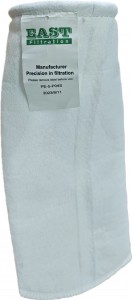
Water Filter Bags: A Key Line of Defense in Water Treatment
In today’s era where requirements for water quality are increasingly stringent, water filter bags, as core components in the water treatment process, play a pivotal role. Whether it is ensuring the smooth progress of industrial production or safeguarding the water safety in our daily lives, water filter bags silently undertake the task of filtering impurities and purifying water quality.The working principle of water filter bags is based on a precise physical filtration mechanism. When water flows through the filter bag, its unique fiber structure, like a fine mesh, can effectively intercept various impurities in the water, including suspended particles, colloidal substances, microorganisms, and other pollutants. These impurities are trapped inside the filter bag, while the purified water passes through smoothly, thus achieving efficient separation of water and impurities.Its filtration precision can be accurately adjusted according to different application needs, ranging from a few microns to hundreds of microns, which can meet the filtration requirements of various complex water qualities. For example, in the electronics industry, for the preparation of ultrapure water, filter bags need to have extremely high filtration precision to remove extremely small particle impurities in the water and ensure the production quality of electronic products; in some industrial fields with relatively low water quality requirements, such as textile printing and dyeing wastewater treatment, filter bags can quickly filter out large particle suspended solids in the water through larger pores, laying the foundation for subsequent advanced treatment.There is a wide variety of material choices for water filter bags, and each material has unique performance characteristics to adapt to different working environments and filtration needs. Common materials include polypropylene (PP), polyester (PE), nylon, and stainless steel. PP material filter bags have excellent acid and alkali resistance, strong chemical stability, can work stably in various chemical corrosion environments, and have relatively low cost, so they are widely used in chemical, pharmaceutical and other industries; PE material filter bags are known for their excellent wear resistance and good high-temperature resistance, can be used for a long time under high-temperature and high-wear working conditions, and are often used in petroleum, metallurgy and other fields; nylon material filter bags have high filtration precision and significant interception effect on tiny particles, and are often used in food and beverage, biopharmaceutical and other industries with extremely strict water quality requirements; stainless steel filter bags have comprehensive advantages such as high strength, corrosion resistance, and high-temperature resistance, and are suitable for some extremely harsh working environments, such as the filtration of drainage from high-temperature and high-pressure chemical reaction kettles.In practical applications, water filter bags show many incomparable advantages. Firstly, their filtration efficiency is extremely high, which can quickly and effectively remove impurities in water, greatly shortening the time of water treatment and improving production efficiency. Secondly, water filter bags have strong dirt-holding capacity, can hold a large number of impurities, reduce the frequency of frequent replacement of filter bags, and lower maintenance costs and labor intensity. Moreover, the installation and replacement of water filter bags are simple and quick, without the need for complex tools and professional skills, even non-professionals can easily complete, which provides convenience for their wide application in various occasions. In addition, water filter bags also have good environmental performance, and their materials are usually recyclable, reducing environmental pollution and conforming to the concept of sustainable development. -
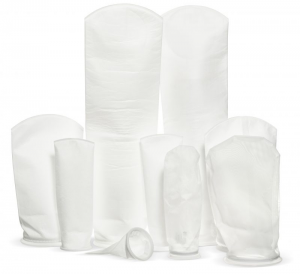
Filter Bags: Unrivaled Filtration Solutions for Diverse Industries
Filter Bags: Unrivaled Filtration Solutions for Diverse IndustriesIn the modern world, where precision and purity are highly valued, filter bags have emerged as indispensable tools across a multitude of industries. These versatile filter bags play a crucial role in ensuring the quality of products and safeguarding the environment by efficiently removing impurities and contaminants.Filter bags find extensive applications in various sectors. In the food industry, filter bags are essential for maintaining the hygiene and taste of food products. Whether it’s the production of beverages like fruit juices and soy milk, or the refining of edible oils, filter bags with their fine – meshed structure can effectively separate residues such as fruit pulp and soybean dregs, guaranteeing a pure and delightful taste. In the industrial realm, filter bags are utilized for the purification of chemical raw materials, filtration of electroplating solutions and paints. High – performance filter bags, such as the BMN series, can provide precise micron – level filtration, meeting the stringent requirements of critical industrial applications. In environmental protection, filter bags contribute significantly to wastewater treatment, helping to separate solid impurities and promoting the recycling of water resources.The diverse range of materials used in filter bags offers unique advantages. Nylon filter bags are renowned for their excellent abrasion resistance and chemical stability. They can withstand high – temperature environments and are ideal for filtering liquids containing particulate impurities, widely used in industrial liquid filtration. Cotton filter bags, made from natural materials, are environmentally friendly and possess superior breathability and moisture absorption, making them perfect for food – related applications. Non – woven filter bags are cost – effective and highly efficient in filtration. They are commonly applied in air filtration, traditional Chinese medicine decoction, and tea – making, effectively filtering out dust and other impurities. Additionally, filter bags made of polyester, stainless steel, and polytetrafluoroethylene also shine in different working conditions, meeting diverse filtration needs.In terms of design and manufacturing, filter bags showcase outstanding craftsmanship. The high – density mesh design enhances filtration efficiency, enabling the capture of even the tiniest particles. Advanced manufacturing techniques, such as hot – melt bonding for non – woven filter bags and high – speed industrial sewing without silicone oil for stitched filter bags, ensure leak – proof performance and prevent contamination of the filtrate. Special attention is also paid to details like removable product labels to avoid any potential pollution. Some filter bags are equipped with stainless – steel collars or galvanized steel rings, which, through argon – arc welding technology, achieve high – precision dimensions, improving the sealing degree and reducing the risk of leakage.Filter bags are not only efficient but also easy to maintain and cost – effective. Most filter bags can be cleaned simply by shaking or rinsing after use. For stubborn stains, appropriate cleaning methods can be adopted according to the material. Their durability means fewer replacements, reducing overall costs. With a wide variety of sizes and specifications available, filter bags can perfectly adapt to different user requirements, from small – scale home use to large – scale industrial production. In conclusion, filter bags are the go – to choice for high – quality filtration, offering reliable solutions for various industries. -
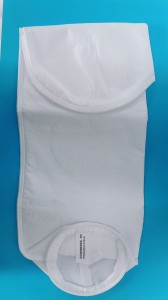
Dewatering Filter Bag for Removing Sediment and Pollutants
A dewatering filter bag is a filtration component specifically designed to separate solid sediments, suspended matter, and pollutants from liquids, widely used in industrial wastewater treatment, municipal sludge dewatering, mining tailings processing, and other scenarios. Its core function is to achieve solid-liquid separation through efficient interception and dewatering, reducing the solid content in liquids or minimizing sludge volume.I. Core Characteristics and Working Principle
1. Key Materials and Structure
- Materials:
- Primarily made of polypropylene (PP) or polyester (PET) fibers, offering acid-alkali resistance and wear resistance;
- Special scenarios (e.g., high temperature, strong corrosion) may use nylon (PA) or polytetrafluoroethylene (PTFE).
- Structural Design:
- Multi-layer composite filter cloth: Coarse outer layer intercepts large particles, while a fine inner layer captures tiny impurities to improve dewatering efficiency;
- High-strength stitching: Reinforced stitching on bag openings and edges prevents tearing during filtration.
2. Working Principle
- Filtration Stage: Sewage containing sediments enters the filter bag, where solid particles are trapped by the filter cloth, and water drains through the cloth pores;
- Dewatering Stage: External forces (e.g., pressure, vacuum, or gravity) squeeze the bag to further extract water from between particles, forming a filter cake with a moisture content of 50–80% (depending on the application).
II. Main Application Scenarios
1. Industrial Wastewater Treatment
- Scenarios: Heavy metal ion precipitates (e.g., copper hydroxide, iron hydroxide), slag particles in wastewater from chemical, metallurgical, and electroplating industries;
- Role: Reduces SS (suspended solids) concentration in wastewater to meet subsequent treatment or discharge standards, while recovering valuable metal particles.
2. Municipal and Environmental Engineering
- Scenarios: Sludge thickening tanks in wastewater treatment plants, river dredging slurry, construction piling wastewater, etc.;
- Role: Rapidly separates water from slurry, reducing sludge volume (volume reduction ratio up to 3:1) and lowering transportation and disposal costs.
3. Mining and Quarrying Industry
- Scenarios: Dewatering of tailings slurry, ore washing wastewater treatment, mine pit drainage purification, etc.;
- Role: 截留 ore particles and heavy metal pollutants, enabling water recycling and reducing environmental risks in tailings ponds.
4. Food and Chemical Industries
- Scenarios: Separation of fruit pulp residues in food processing wastewater, crystallization products in chemical reactions, etc.;
- Role: Recovers solid raw materials (e.g., starch, sugar residue) while purifying wastewater.
III. Key Selection Parameters
1. Filtration Precision and Pore Size
- Precision Range: Typically 5–200 microns, matched to sediment particle size:Pore Size Distribution: Choose surface filtration (uniform pores) or deep filtration (gradient pores). The former suits uniform particle 污水,while the latter fits complex water with multiple particle sizes.
- Coarse particles (e.g., sand): 50–200 microns;
- Fine suspended matter (e.g., colloids): 5–50 microns.
2. Dewatering Performance Indicators
- Water Permeability: Water flux per unit filter cloth area (L/m²·h). Higher permeability speeds up filtration but requires balancing with interception efficiency;
- Water Retention: The ability to retain water in the filter cake. Poor water retention improves dewatering efficiency (e.g., when used with flocculants).
3. Pressure Resistance and Strength
- Operating Pressure: Matches the pressure type of dewatering equipment (e.g., plate-and-frame filter presses can reach 0.6–1.0MPa, while vacuum filtration uses negative pressure);
- Tear Resistance: Select filter cloth with warp and weft tensile strength ≥1500 N/m to avoid damage under high pressure.
4. Chemical Compatibility
- pH Tolerance:Solvent Resistance: Choose PET or PTFE for oily wastewater to prevent PP from swelling and damaging.
- PP material: Suitable for pH 1–14 (resistant to strong acids and alkalis);
- PET material: Suitable for pH 4–10 (resistant to weak acids and alkalis, not concentrated acids).
IV. Supporting Equipment and Processes
1. Common Dewatering Equipment
- Plate-and-Frame Filter Press: Exerts hydraulic pressure to squeeze filter bags, suitable for high-concentration slurry dewatering with low filter cake moisture content (≤60%);
- Vacuum Filter: Uses negative pressure to suction water, suitable for fine-particle sludge with high processing efficiency but higher energy consumption;
- Centrifugal Filter: Separates solid-liquid via centrifugal force, suitable for uniform particle sediments with small footprint.
2. Pretreatment Processes
- Flocculant Addition: Adds polyaluminum chloride (PAC) or polyacrylamide (PAM) to sewage to agglomerate fine particles into large flocs, improving filter bag interception efficiency and dewatering speed;
- Pre-Filtration: Uses coarse filter bags (e.g., 200 microns) to remove large particles, protecting fine filter bags and extending service life.
V. Maintenance and Environmental Considerations
1. Maintenance Tips
- Cleaning Frequency:Damage Inspection: Regularly check stitching and the bottom of the bag, and replace promptly if damage is found to prevent material leakage.
- Reusable filter bags: Backwash with high-pressure water after each dewatering to remove residual particles in filter cloth pores;
- Disposable filter bags: Replace immediately when saturated to avoid clogging and reduced filtration efficiency.
2. Environmental Treatment
- Filter Cake Disposal: Filter cakes with high heavy metal content must be treated as hazardous waste (e.g., stabilized landfilling); general industrial filter cakes can be used for brick-making, landfilling, or incineration;
- Filter Bag Recycling: Choose recyclable materials (e.g., PP, PET) and send them to professional recycling companies to reduce white pollution.
VI. Comparison with Other Filtration Methods
Filtration Method Applicable Solid Content Post-Dewatering Moisture Content Cost (¥/ton of wastewater) Advantages Dewatering Filter Bag 5–50 g/L 50–80% 5–15 Low cost, simple operation Membrane Separation ≤5 g/L 90–95% 20–50 High precision, high automation Centrifugal Separation 10–100 g/L 60–85% 10–20 High efficiency, small footprint Selection Advice: Prioritize dewatering filter bags for medium-to-high solid content wastewater (>10 g/L), especially in cost-sensitive or mobile operation scenarios (e.g., emergency drainage, temporary construction wastewater treatment). For further optimization, provide parameters such as sewage composition and treatment volume to customize filter bag specifications and processes. - Materials:
-
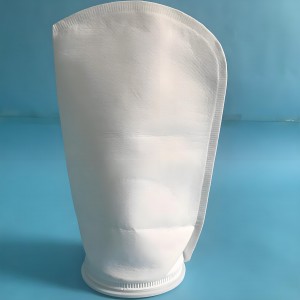
bag filters for water treatment
Bag filters are commonly used filtration devices in the water treatment field. They intercept suspended solids, colloids, particulate impurities, etc., in water through built-in filter bags, featuring simple structure, high filtration efficiency, and convenient maintenance. Below is key information and application highlights:I. Core Components and Working Principle
1. Main Structure
- Filter Housing: Mostly made of stainless steel (e.g., 304/316L) or engineering plastics, pressure-resistant and corrosion-resistant, with inlet, outlet, and filter bag chamber.
- Filter Bag: Constructed from synthetic fibers like polypropylene (PP) or polyester (PET), with precision ranging from 1–500 microns, fixed inside the filter via a top ring.
- Support Basket: Secures the filter bag to prevent deformation during filtration and guides uniform water flow through the filter media.
2. Working Principle
- Water to be treated flows into the filter through the inlet. As it passes through the filter bag, impurities are trapped inside the bag, while clean water exits through the outlet via filter bag pores.
- When the filter bag is saturated with contaminants (judged by inlet-outlet pressure difference, e.g., >0.1MPa), the bag needs replacement without disassembling the entire system.
II. Main Types and Characteristics
1. Classification by Housing Type
Type Characteristics Application Scenarios Single-bag filter Contains only 1 filter bag, compact structure, small flow rate (5–50 m³/h), low cost. Small systems, laboratories, household water purification Multi-bag filter Can install 2–24 filter bags in parallel, large flow rate (up to 500 m³/h), requires manifold design. Industrial water treatment, municipal water supply (large systems) Top-inlet/side-inlet Different inlet positions; top-inlet ensures more uniform water flow, while side-inlet suits space-constrained scenarios. Selected based on installation space 2. Classification by Pressure Rating
- Low-pressure type: ≤0.3MPa, suitable for normal or low-pressure scenarios (e.g., municipal tap water filtration).
- Medium-high pressure type: 0.6–1.6MPa, ideal for high-pressure systems like industrial circulating water or RO pretreatment.
III. Advantages and Limitations
Advantages
- Flexible filtration precision: Can meet various needs from coarse to fine filtration by replacing filter bags of different precisions (1–500 microns).
- High dirt-holding capacity: Deep filter bag structure retains more impurities, extending replacement cycles (30–50% higher dirt capacity than cartridge filters).
- Low maintenance cost: Filter bags can be replaced without professional tools, with low individual bag cost (¥10–200), minimizing downtime.
- High compatibility: Suitable for various water qualities (acidic/alkaline liquids, oily wastewater, high-temperature water) via material selection for bags and housings.
Limitations
- Higher pressure loss: Deep filtration structure causes greater water flow resistance than precise filtration methods like membrane filtration.
- Low automation level: Requires manual monitoring of pressure difference or regular bag replacement, unsuitable for unmanned scenarios (can be improved with automatic pressure alarms).
IV. Typical Application Scenarios
1. Industrial Water Treatment
- Circulating cooling water filtration: 截留 algae, sediment, rust, etc., to prevent heat exchanger blockage and extend equipment life.
- Chemical wastewater pretreatment: Removes suspended solids and colloids for subsequent biochemical or membrane treatment.
- Metalworking fluid filtration: Filters metal chips and sludge from cutting fluids for recycling.
2. Municipal and Civil Applications
- Waterworks pretreatment: Further removes fine particles after sedimentation to improve water clarity.
- Sewage plant deep filtration: Serves as a post-secondary clarifier unit to reduce effluent SS (suspended solids) concentration for compliance.
- Commercial/household water purification: Used in pool filtration, direct drinking water pretreatment (with activated carbon filter bags), etc.
3. Special Industry Applications
- Food and beverage industry: Filters impurities from syrups and alcoholic beverages to meet hygiene standards (requires FDA-certified food-grade filter bags).
- Pharmaceutical and electronics industry: Prepares high-purity water by intercepting particulate contaminants for reverse osmosis (RO) or EDI systems.
V. Selection and Maintenance Tips
1. Key Selection Parameters
- Flow rate and number of filter bags: Choose single or multi-bag filters based on system flow. A single No. 2 filter bag (810mm length) handles ~30 m³/h at 50-micron precision.
- Material compatibility:Precision selection: Based on impurity particle size (e.g., ≤5 microns for RO pretreatment, 50–100 microns for coarse filtration).
- Acidic liquids: PP filter bag + stainless steel housing;
- Oily wastewater: PET filter bag + anti-corrosion coated housing;
- High-temperature liquids (>80℃): high-temperature-resistant PET filter bag.
2. Maintenance Recommendations
- Replacement cycle:
- Normal water quality: Replace every 1–3 months (pressure difference-dependent);
- High-turbidity water: Inspect weekly and replace immediately when pressure difference reaches 0.1MPa.
- Operation notes:Environmental treatment: Prioritize degradable filter bags or centralized recycling for disposable bags to reduce pollution.
- Relieve pressure before replacing bags to avoid high-pressure water impact;
- Ensure the bag’s sealing ring tightly fits the filter to prevent bypass flow.
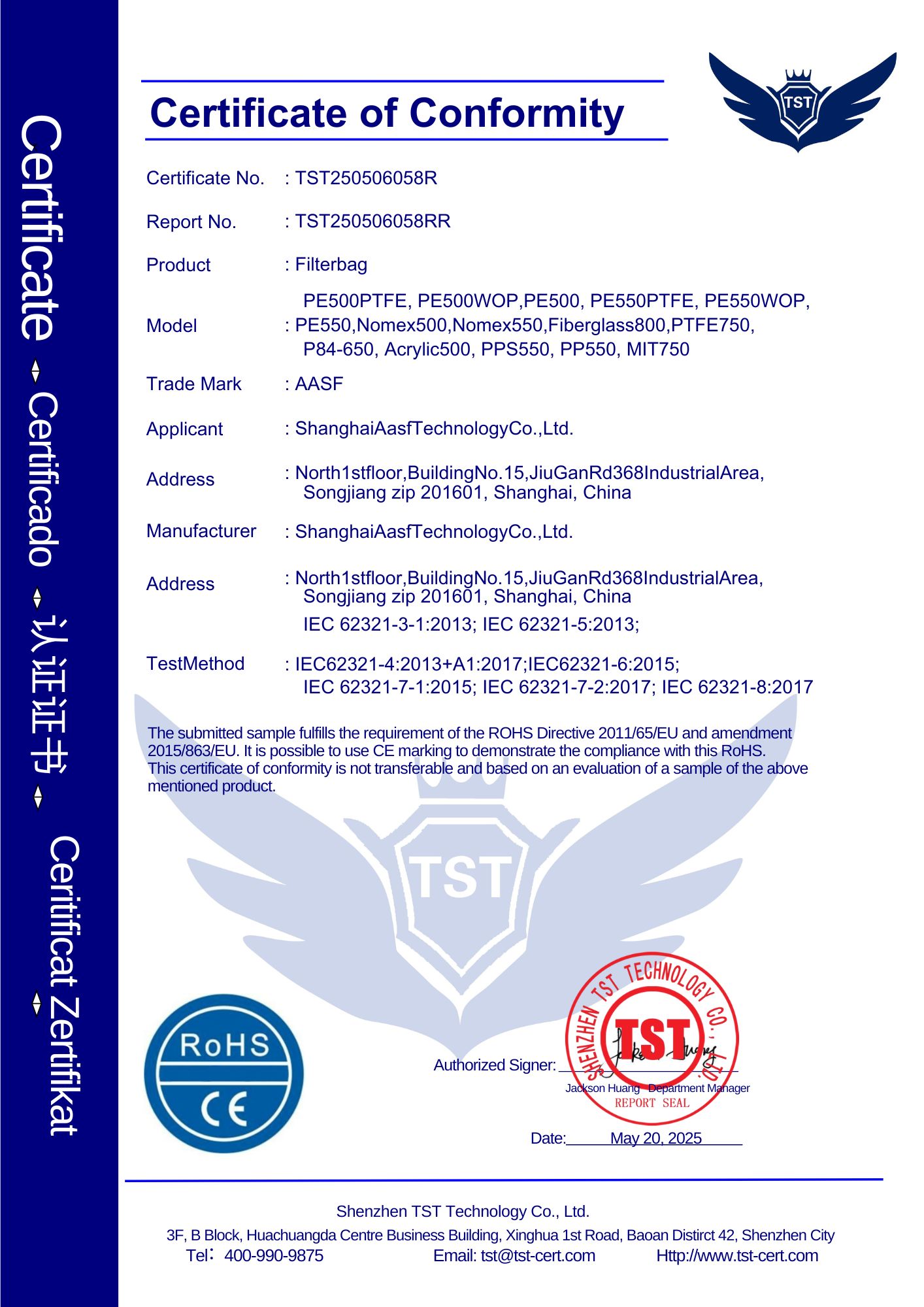
-
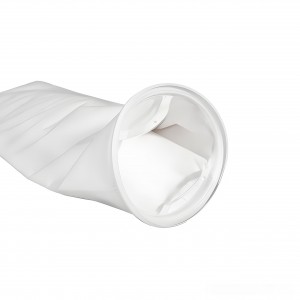
How to select water filter bags suitable for specific water treatment needs?
Choosing the right water filter bags for specific water treatment requirements requires comprehensive consideration of water quality characteristics, treatment objectives, system parameters, and application scenarios. Below is a detailed selection process and key considerations:I. Clarify water quality and treatment objectives
1. Analyze water source impurity characteristics
- Particle types: Suspended solids (e.g., sediment, rust), colloids (e.g., clay, microorganisms), oils, or specific pollutants (e.g., metal ions, organic matter).
- Particle size: Determine the main impurity particle size range through water quality testing (e.g., coarse particles >50 microns, fine particles <10 microns).
- Chemical properties: Liquid acidity/alkalinity (pH value), corrosiveness (e.g., chloride ions, strong oxidizers), and temperature (normal or high-temperature environments).
2. Define filtration goals
- Precision requirements: Target filtration accuracy (e.g., drinking water ≤5 microns, industrial circulating water up to 50 microns).
- Treatment volume: Water flow rate per unit time (e.g., 10 m³/h, 100 m³/h), affecting filter bag size and quantity.
- Impurity interception capacity: Concentration of contaminants to be intercepted (high-turbidity water sources require high dirt-holding capacity filter bags).
II. Core selection parameters
1. Filtration precision (critical parameter)
- Precision range: Common filter bag precisions range from 1–500 microns, selected based on impurity particle size.Note: Excessively high precision may cause rapid clogging; balance filtration efficiency with flow rate.
- Examples:
- Swimming pool water filtration: 20–50 microns (removes hair, sediment).
- Pre-treatment for electronic-grade ultrapure water: 1–5 microns (intercepts tiny particles).
- Chemical wastewater oil removal: 10–25 microns (paired with demulsification processes).
- Examples:
2. Material compatibility
- Common materials and applications:
Material Corrosion resistance Temperature resistance Typical applications Polypropylene (PP) Resistant to acids, alkalis, salt solutions ≤80℃ Industrial wastewater, municipal sewage, food processing Polyester (PET) Resistant to oil and general solvents ≤120℃ Lubricating oil filtration, oily wastewater treatment Nylon (PA) Resistant to strong alkalis, wear-resistant ≤90℃ High-turbidity water sources, metalworking fluid filtration - Selection principles:
- Choose PP material for acidic liquids and PA or PET for alkaline liquids.
- Select PET or special high-temperature-resistant fibers for high-temperature environments (e.g., boiler water).
3. Filter bag size and structure
- Specification categories:
- No. 1 bag: Diameter 110mm, length 380mm, flow rate ~5–15 m³/h (common in small systems).
- No. 2 bag: Diameter 180mm, length 810mm, flow rate ~20–50 m³/h (mainstream for medium-to-large systems).
- Others: No. 3 bags, No. 4 bags, or non-standard custom sizes.
- Structural design:
- Monofilament filter cloth: Smooth surface, easy to clean, suitable for intercepting large particles (coarse filtration).
- Multifilament/needle-punched filter cloth: Deep filtration, high dirt-holding capacity, suitable for fine particle filtration.
- Reinforced ring design: Stainless steel or plastic rings at the top to prevent bag mouth tearing and improve pressure resistance.
4. Pressure resistance and flow matching
- System pressure: Filter bags must withstand ≥ system operating pressure (typically 0.1–0.6MPa); use thickened materials or metal frame supports for high-pressure scenarios.
- Flow calculation:
- A single No. 2 bag at 50-micron precision has a flow rate of ~30 m³/h; for a 100 m³/h system, parallel 4 bags (with redundancy).
III. Other key factors
1. Dirt-holding capacity and replacement cycle
- Dirt-holding capacity: Total amount of impurities a filter bag can retain (unit: g/bag); high capacity reduces replacement frequency.
- Estimation method:
- For known suspended solids concentration (e.g., 500 mg/L) and total treatment volume (e.g., 1000 m³), total impurity weight = 500 mg/L × 1000 m³ = 500 kg.
- If a single filter bag holds 5 kg, it needs to be replaced 100 times per cycle, or increase the number of filter bags to reduce frequency.
2. Environmental protection and cost
- Disposable vs. washable:Material recyclability: Prioritize recyclable PP/PET materials to reduce plastic pollution.
- Disposable filter bags: Low cost (~¥10–50/bag), suitable for complex impurities or non-washable scenarios.
- Washable filter bags: Higher cost (~¥200–500/bag) but reusable, ideal for high-value liquids or strict environmental requirements.
3. Compatibility with supporting equipment
- Filter type: Must match filter bag size (e.g., No. 1 bag for small filters, No. 2 bag for standard filters).
- Sealing method: O-ring or flange sealing to ensure no leakage.
IV. Selection process example
Scenario: A food factory needs to filter production water containing sediment (particle size 20–100 microns), with a flow rate of 50 m³/h and normal-temperature neutral water.- Precision selection: Intercept particles >20 microns, choose 25-micron precision filter bags.
- Material selection: Neutral water, choose economical and durable PP material.
- Size selection: Single No. 2 bag flow rate 30 m³/h, require 2 bags in parallel (total flow 60 m³/h to cover 50 m³/h demand).
- Structure selection: Needle-punched filter cloth (deep filtration, high dirt-holding capacity) with stainless steel reinforcing rings.
- Replacement cycle: Estimated daily treatment volume 400 m³, inlet suspended solids concentration 200 mg/L, daily impurity total 80 kg; single bag dirt-holding capacity 5 kg, requires daily replacement of 2 bags (or replace every 2 days with spare bags).
V. Notes
- Testing and verification: For high-requirement scenarios (e.g., pharmaceuticals, electronics), test with sample filter bags first to confirm filtration efficiency and service life.
- Supplier qualification: Choose ISO-certified manufacturers to ensure filter bags meet hygiene standards (e.g., food-grade requires FDA certification).
- Emergency plans: Stock spare filter bags to avoid system downtime; regularly inspect for damage (replace immediately if pressure drop surges).
-
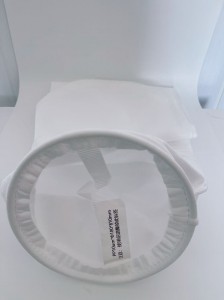
Water filter bag,Do water filter bags work?
A water filter bag is a filtration component used in the water treatment field, primarily designed to intercept suspended solids, colloids, particulate impurities, etc., in water to purify the water quality or meet specific process requirements. Its materials are typically corrosion-resistant and wear-resistant synthetic fibers such as polypropylene (PP) and polyester (PET), which are made into filter fabrics of different precisions through needle punching, weaving, or other processes, and then sewn into a bag-like structure.Main Features
- Diverse Filtration Precisions
- The precision range typically spans 1–500 microns. Filter bags with different pore sizes (e.g., 10 microns, 50 microns) can be selected according to water quality requirements to meet various needs such as coarse filtration and fine filtration.
- High Interception Efficiency
- The deep filtration structure effectively captures impurities of different particle sizes, with a large dirt-holding capacity and long service life.
- Chemical Corrosion Resistance
- The materials are resistant to acids, alkalis, and most chemical reagents, suitable for multiple scenarios such as industrial wastewater, municipal sewage, and food processing water.
- Convenient Replacement
- The bag-type structure is easy to install and replace without professional tools, reducing maintenance costs.
Application Scenarios
- Industrial Water Treatment: For example, filtration of circulating cooling water, pretreatment of chemical wastewater, and filtration of metalworking fluids to remove suspended solids and mechanical impurities.
- Municipal Water Supply/Sewage Treatment: Used for pretreatment in waterworks and secondary filtration in sewage plants to improve water clarity.
- Food and Beverage Industry: Filters production water, syrups, alcoholic beverages, etc., to ensure products meet hygiene standards.
- Pharmaceutical and Electronics Industry: Used for pretreatment of high-purity process water to intercept particulate contaminants and meet clean production requirements.
Selection Considerations
- Filtration Precision: Choose appropriate precision based on the particle size of impurities in the water source and treatment objectives (e.g., 50 microns for swimming pool water filtration, 1 micron for electronic-grade water).
- Material Compatibility: Ensure that the filter bag material is chemically compatible with the liquid to be treated (e.g., polypropylene for acidic liquids).
- Flow Rate and Pressure: Select filter bag sizes (e.g., No. 1 bag, No. 2 bag, etc.) according to the system flow rate, and ensure pressure resistance meets working conditions.
- Support Structure: Needs to be used with a bag filter; pay attention to the matching of the filter’s diameter, sealing method, and filter bag.
- Environmental Requirements: Prioritize recyclable materials or filter bags that meet environmental standards to reduce secondary pollution.
- Diverse Filtration Precisions
-
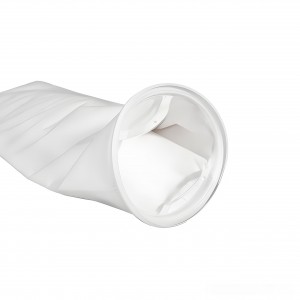
Product Advantages of Water Filter Bags: Superior Performance Making It the Industry’s First Choice
Water filter bags hold a pivotal position in the water treatment market and are highly favored by various industries. This is mainly due to a series of remarkable and unique product advantages they possess.High – efficiency Filtration Performance for Precise Water Purification
One of the core advantages of water filter bags is their outstanding filtration performance. According to different filtration requirements, it can accurately match filter cloths of various pore sizes, efficiently intercepting impurities ranging from large particles in millimeters to fine impurities in microns or even nanometers. For example, in industrial wastewater treatment, the wastewater from some metal processing industries often contains a large number of large – sized metal debris, sediment and other impurities, as well as micron – sized colloidal particles and bacteria and microorganisms generated by chemical reactions. By carefully selecting the appropriate pore – sized filter cloth, water filter bags can separate these impurities of different particle sizes one by one, making the treated. -
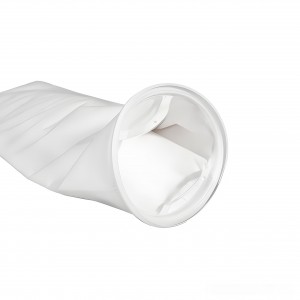
The wide application scenario of water filter bag: protect the water safety of various industries
With its excellent filtration performance, water filter bags have a wide range of applications in many fields, providing a strong guarantee for the water safety and production process in various industries.
In the field of drinking water treatment, water filtration bags are an important line of defense to ensure healthy drinking water for residents. When the water works purify the raw water, filter bags with different precision will be used to remove impurities such as sediment, algae, bacteria and some viruses in the water. After layers of filtration, the raw water meets the drinking water sanitation standards stipulated by the state before it is transported to thousands of households. For example, in some areas where the water source is polluted, by installing high-precision water filter bag equipment, harmful pollutants can be effectively removed from the water, so that residents can drink soothing water.
In industrial production, water filter bags play an irreplaceable role. In the electronics industry, the production process has very high requirements for water quality, and even extremely small impurities can affect the quality of electronic products. The water filter bag can accurately filter out the particles and microorganisms in the water, providing ultra-pure water for chip manufacturing, circuit board cleaning and other processes to ensure the stable performance of electronic products. In the chemical industry, a variety of chemical reactions require pure water as a raw material or reaction medium. The water filter bag can remove impurities and harmful ions in the water, prevent these substances from interfering with the chemical reaction, and ensure the quality of chemical products and the smooth progress of the production process.
In the field of environmental protection, water filter bags perform well in sewage treatment and rainwater collection and utilization. Sewage treatment plants use filter bags to pretreat sewage, remove large particles of impurities, and reduce the burden of subsequent treatment process. In the rainwater collection system, the filter bag can filter out the impurities such as leaves and dust in the rainwater, so that the collected rainwater can be used for non-drinking purposes such as irrigation and car washing, and realize the effective use of water resources.
In addition, in aquaculture, landscape fountains and other fields, water filtration bags also play an important role in maintaining the cleanliness and ecological balance of water bodies. It can be said that the application scenarios of water filter bags are extremely wide, and it is like a silent guardian to protect the quality of water in various industries.